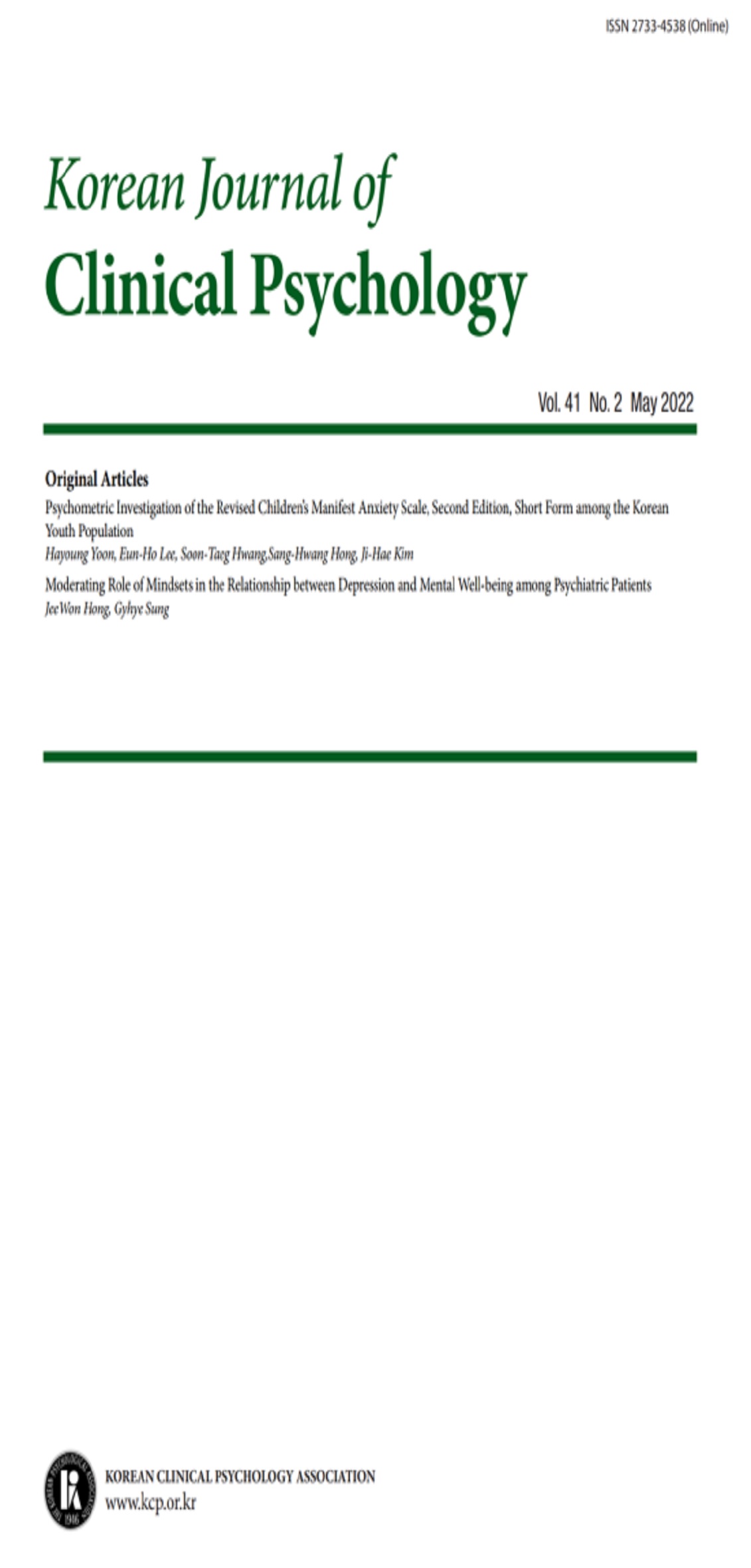open access
메뉴
open access
메뉴 E-ISSN : 2733-4538
E-ISSN : 2733-4538
본 연구는 정서적 강도와 정서조절방략의 관련성을 정서조절방략 질문지(ERSQ)를 사용하여 경험적으로 확인하고자 하였다. 이를 위해 대학생 집단을 대상으로 정서강도 척도(AIM)와 ERSQ의 상관분석을 실시하였다. 그 결과, 첫째, 정서강도는 ‘부정적으로 생각하기’, ‘타인 비난하기’, ‘타인에게 부정적 감정 분출하기’, ‘안전한 상황에서 부정적 감정 분출하기’, ‘폭식하기’, ‘탐닉활동 하기’ 등의 6개 부적응적 방략과 유의미한 정적 상관을 보였다. 둘째, 정서강도는 주의 분산적 방략에 속하는 ‘수동적으로 생각하기’, ‘즐거운 상상하기’, ‘기분전환활동 하기’ 3개 방략과 지지 추구적 방략에 해당되는 ‘감정을 표현하고 공감 얻기’, ‘조언이나 도움 구하기’, ‘친밀한 사람 만나기’ 3개 방략에 유의미한 정적 상관을 보였다. 셋째, 불쾌한 감정이나 상황에 접근하여 정서적 변화를 유도하는 접근적 방략 4개는 유의미한 상관을 보이지 않았다. 끝으로 본 연구에 대한 시사점과 제한점 그리고 추후 연구에 대해 논의하였다.
This study investigated the relationship between affect intensity and emotion regulation strategies, using the Emotion Regulation Strategy Questionnaire (ERSQ). The correlation between the Affect Intensity Measure (AIM) and the ERSQ was examined among undergraduate students. The results were as follows. Six maladaptive strategies (“Think negatively”, “Blame others”, “Burst into negative emotion to others”, “Burst into negative emotion in a secure situation”, “Binge eating” and “Be engaged in addictive activity”) were positively correlated with affect intensity. Three distractive strategies (“Think passively”, “Imagine pleasurable things” and “Refresh oneself”) and three support-seeking strategies (“Express emotion and win the empathy”, “Ask for advice or help” and “Meet intimate person”) were positively correlated with affect intensity. However, affect intensity was not significantly correlated with four strategies that induced emotional change by approaching unpleasant emotions or situations. The study presents and discusses implications of these results, limitations of the study itself, and suggestions for future research.
민경환, 김지현, 윤석빈, 장승민 (2000). 부정적 정서 조절 방략에 관한 연구: 정서 종류와 개인 변인에 따른 정서조절 양식의 차이. 한국심리학회지: 사회 및 성격, 14(2), 1-16.
옥수정 (2001). 억압적 성격성향자의 정서적 특성과 정서조절방략. 서울대학교 석사학위논문.
이지영, 권석만 (2006). 정서조절과 정신병리의 관계: 연구 현황과 과제. 한국심리학회지: 상담 및 심리치료, 18(3), 461-493.
이지영, 권석만 (2007). 정서조절방략 질문지의 개발: 대학생 집단을 대상으로. 한국심리학회지: 임상, 26(4), 963-976.
이지영, 권석만 (2009a). 정서장애와 정서조절방략의 관계. 한국심리학회지: 임상, 28(1), 245-261.
이지영, 권석만 (2009b). 정서조절방략 질문지(ERSQ)의 16개 방략의 경험적 구분. 한국임상심리학회’ 2009년도 동계 연수회 포스터 발표 초록집, 31-32.
조성은, 오경자 (2007). 정서인식의 명확성, 정서강도, 정서주의력과 스트레스 대처 및 우울과의 관계. 한국심리학회: 건강, 12(4), 797-812.
한정원 (1997). 정서표현성이 건강 및 주관적 안녕에 미치는 영향. 서울대학교 석사학위논문.
Catanzaro, S. J. (1997). Mood regulation expectancies, affect intensity, dispositional coping, and depressive symptoms: A conceptual analysis and empirical reanalysis. Personality and Individual Differences, 23(6), 1065-1069.
Cole, P. M., Michel, M. K., & Teti, L. O. (1994). The development of emotion regulation and dysregulation: A clinical perspective. In N. A. Fox (Ed.), The development of emotion regulation. Biological and behavioral considerations (pp.73-100). Monographs of the Society for Research in Child Development, 59 (2-3, Serial No. 240).
Endler, N. S., & Parker, J. D. A. (1990). Multidimensional assessment of coping: A critical evaluation. Journal of Personality and Social Psychology, 58(5), 844-854.
Fivush, R., & Buckner, J. P. (2000). Gender, sadness, and depression: The development of emotional focus through gendered discourse. In A. Fischer (Ed.), Gender and emotion: Social psychological perspectives (pp.232-253). Cambridge: University Press.
Flett, G. L., Blankstein, K. R., & Obertynski, M. (1996). Affect intensity, coping styles, mood regulation expectancies, and depressive symptoms. Personality and Individual Differences, 20(2), 221-228.
Fosha, D. (2000). The transforming power of affect. Basic Books.
Garber, J., & Dodge, K. (1991). The development of emotion regulation and dysregulation. New York: Cambridge University Press.
Garnefski, N., Kraaij, V., & Spinhoven, P. (2001). Negative life events, cognitive emotion regulation and emotional problems. Personality and Individual Differences, 30, 1311-1327.
Gratz, K. L., & Roemer, L. (2004). Multidimentional assessment of emotion regulation dysregulation: Development, factor structure, and initial validation of the Difficulties in Emotion Regulation scale. Journal of Psychopathology and Behavioral Assessment, 26(1), 41-54.
Greenberg, L. S. (2002). Emotion-focused therapy. Coaching clients to work through their feelings. Washington: American Psychological Association.
Gross, J. J. (1999). Emotion regulation: past, present, future. Cognition and Emotion, 13(5), 551-573.
Gross, J. J., & John, O. P. (2003). Individual difference in two emotion regulation processes: Implications for affect, relationships, and well-being. Journal of Personality and Social Psychology, 85(2), 348-362.
Hayes, S. C., Luoma, J. B., Bond, F. W., Masuda, A., & Lillis, J. (2006). Acceptance and commitment therapy: Model, processes and outcomes. Behaviour Research and Therapy, 44, 1-25.
Kring, A. M., & Werner, K. H. (2004). Emotion regulation and psychopathology. In P. Philippot, & R. S. Feldman(Ed.). The regulation of emotion (pp.359-385). Lawrence Erlbaum Associates.
Larsen, R. J. (1984). Theory and measurement of affect intensity as an individual difference characteristic. Dissertation Abstracts International, 85, 2297B.
Larsen, R. J., & Diener, E. (1987). Affect intensity as an individual difference characteristic: A review. Journal of Research in Personality, 21, 1-39.
Marra, T. (2005). Dialectical Behavior Therapy in Private Practice. New Harbinger Publications.
Omaha, J. (2004). Psychotherapeutic interventions for emotion regulation. EMDR and bilateral stimulation for affect management. New York: W. W. Norton & Company.
Rachman, S. (1980). Emotional processiong. Behavior Research and Therapy, 18, 51-60.
Westen, D. (1994). Toward an integrative model of affect regulation: Applications to social- psychological research. Journal of Personality, 62, 641-667.
Williams, D. G. (1989). Neuroticism and extraversion in different factors of the Affect Intensity Measure. Personality and Individual Differences, 10, 1095-1100.
